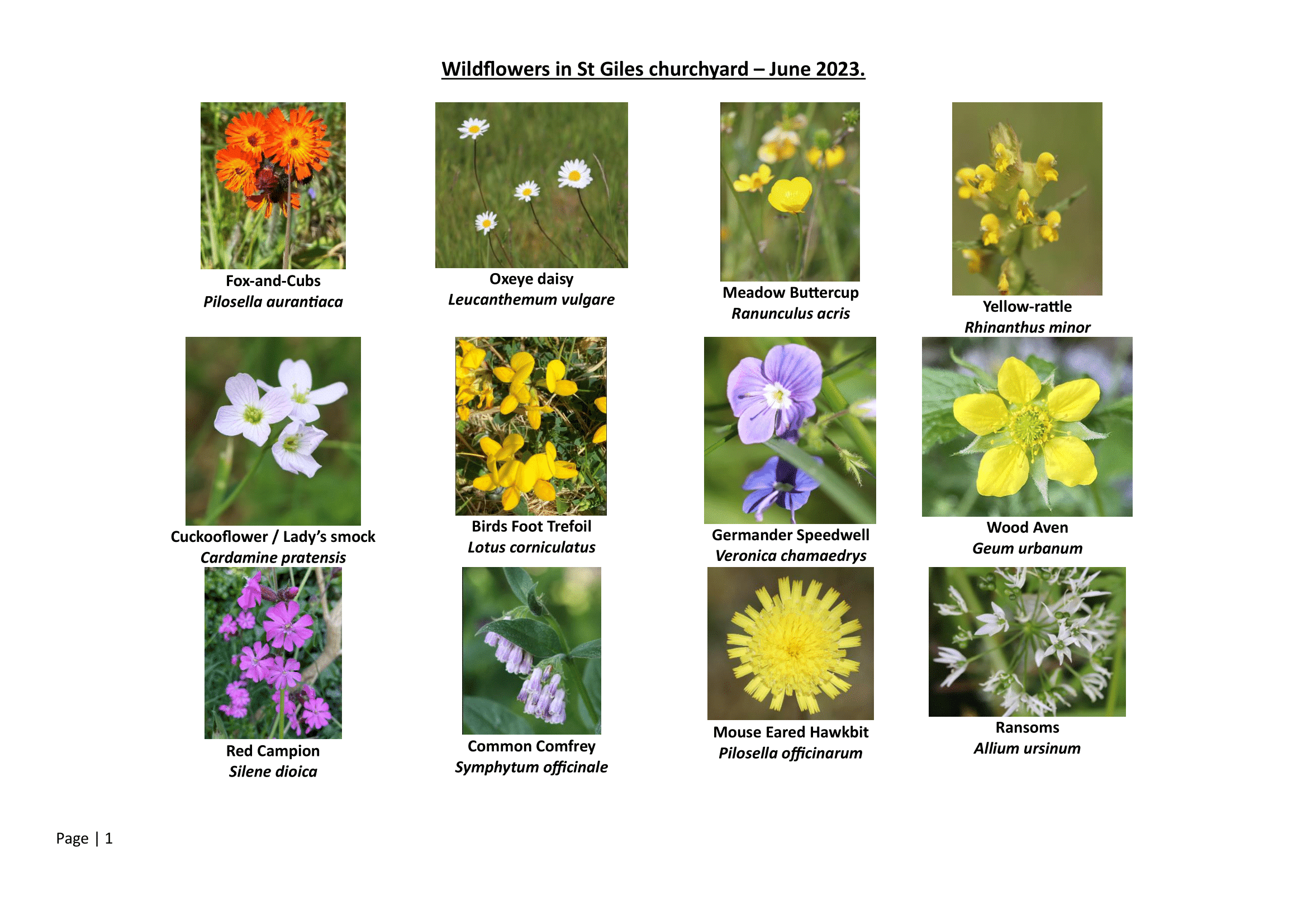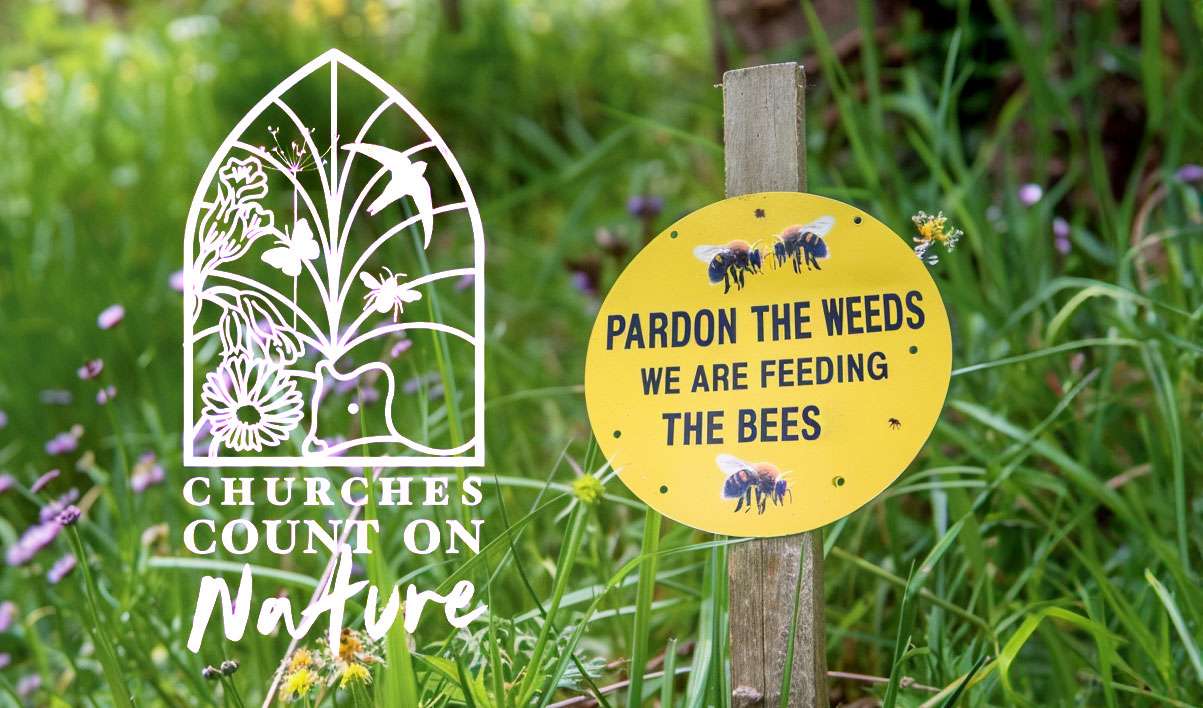Churches across all denominations in England and Wales can now register to participate in Churches Count on Nature 2025 – an annual scheme where people visit church and chapel yards and record the plant and animal species they encounter. Often, this land is home to precious biodiverse habitats and managing them for people and nature is important.
The biodiversity survey, supported by environmental charities A Rocha UK and Caring for God’s Acre, as well as the Church of England and the Church in Wales, takes place from 7th – 15th June 2025. Churches Count on Nature is part of Love Your Burial Ground Week.
If you don’t have a churchyard or graveyard, you can still participate by connecting with another local church that does. Or maybe you could get a local school or wildlife group involved?
Find out more, including how to access resources, record your sightings, and register your event here. There is also a map showing events already registered – why not explore what is happening in your local area?
Inspiration from churches who hosted a Churches Count on Nature event in previous years
St Anne’s, Penparcau, Aberystwyth

Eco Church does take you to some strange and interesting places, but I’d never imagined that it would lead me to a church committee meeting where I would be asking for permission to build a sunbed …for reptiles …at church. You can imagine the looks that I got!
So, how did I end up there, and was I successful? Well, in spring 2023, St Anne’s, Penparcau, Aberystwyth, already held a bronze Eco Church award. As we worked towards silver, we were starting to realise how much more we, as a church, could do to support creation with the small amount of land that we have. It wasn’t about doing everything perfectly, or about having huge plans, but about making small, positive changes where we could and letting nature do what nature does. We had a log pile in a quiet corner of the church grounds, and I went online to research where we might add another for better habitat diversity.
I ended up on the RSPB website, and after reading about log piles I got drawn in to some of their other pages. And there it was! They’ve changed the page title now, but then it was “Build a reptile sunbed” (here is a link to the updated article). It was so easy – it just needed half a corrugated roofing sheet, and a quiet piece of land in the sun, and we – you – could add a new habitat to the church grounds. It was so simple! St Anne’s has a wild, barely accessible bank by the church, and the top of the bank is in the sun for most of the day, so it seemed ideal.
Well, the church committee said yes, and we built the reptile sunbed at St Anne’s. By virtue of it being in a wild, difficult to access area, we don’t check it very often, but there is nearly always some wildlife there. And I guess that’s the point – the positive changes that we make allow creation to thrive, and that boosts the ecosystem, which allows more of creation to thrive. And this year, this year we will get up there and do a proper survey for Churches Count on Nature.
– Reptile sunbed at St Anne’s, Penparcau, Aberystwyth

St Giles Church, Hartington
A wildflower survey during Churches Count on Nature identified 39 different species in the churchyard. Taking church outside during a Sunday service, the congregation were invited to explore what wildflowers and trees could be found in their churchyard, with the following challenge:
See how many of the twelve flowers on the sheet you can find and look out for others as well – 39 different wildflowers and plants were
counted earlier this week – not including grasses and trees! As you walk around the churchyard, take a look at areas that have
been left unmown this year for the first time (along the borders and at the rear of the church) and see how many flowers you can spot.


– Wildflowers in St Giles churchyard
 Penyrheol Baptist Chapel
Penyrheol Baptist Chapel
Nestling high up in the shadows of Twmpa, you will find Penyrheol Baptist Chapel. Being three miles from the nearest hamlet, it is known both for its remoteness and the stunning Welsh beauty of its location. Nevertheless, its building remains the monthly gathering place for a faithful community of worshippers, and the grounds provide the location where young families come together for a Go Wild! family club. In a place that provides a home to such a wonderful variety of flora and fauna, the Churches Count on Nature initiative gave those who worship at Penyrheol the perfect opportunity to be better stewards of what God has gifted us with.
Last year, we chose to set aside one Sunday afternoon during the designated week to get involved and run a pilot project. In the run-up to the event, we spoke with people from other local groups who have a deep commitment to the environment. Invitations to join us were circulated to the community explaining the background of the event and emphasising that no expertise was necessary. The iNaturalist App and the very helpful resources supplied as part of Churches Count on Nature allowed even the beginner to discern a Cow Slip from a Primrose!
The afternoon began with an optional 15-minute service in the Chapel, where we gave thanks to God for His creation and remembered our responsibilities as His stewards. Then the exploring and counting began. Our numbers on this occasion were small and gathered entirely from the Penyrheol community.
However, there was great excitement as we discovered together previously unnoticed gems and discovered anew the grounds that we thought we were so familiar with. And ‘experts’ emerged amongst our number who, whilst enjoying a cup of tea and a piece of cake, could name every species… at least with its colloquial name!
And so, to this year. Building upon last year’s experience, we are looking forward to welcoming people once again to the glorious surroundings of Penyrheol Chapel to join us for Churches Count on Nature. If you are in the area, why not come along?
You can find Penyrheol Chapel at LD3 0SR or ///texts.dance.uniform
All Saints Church, Hemblington, Norfolk
As part of Churches Count on Nature and Great Big Green Week we encouraged visitors to look in on an exhibition in church, and then to attend a Saturday morning churchyard wildlife survey, followed by two natural history presentations in church. The Eco-team produced a “Let’s Go Green” pamphlet made available to visitors, who were also asked to complete a lifestyle survey. We are fortunate to live in a rural area of Norfolk with many of the Friends of the church being keen naturalists. They have also encouraged other local people into the church and churchyard which has helped fundraising for church repairs as well as a good community spirit.
 CCoN on the Isle of Anglesey, off the north-west coast of Wales
CCoN on the Isle of Anglesey, off the north-west coast of Wales
Many of the Island’s churches are keen on doing their bit for biodiversity. Llanidan Church (amongst others) held a community event as part of Churches Count on Nature. The event started with a service that focussed on the environment and caring for God’s creation, which was followed by refreshments and an opportunity to browse the large displays of books, leaflets and other items on various aspects of flora and fauna. Some 32 people took part in the survey of wildflowers, insects, and more, and lists were compiled in Welsh, English and French – as a Breton gentleman took part! There were nearly 80 different species of wildflowers identified as well as a variety of insects and birds.



-Wildflowers and recordings from Llanidan Church
Northchurch Baptist Church, Hertfordshire
Just along the road from our current church building sits the site of the original Victorian Baptist church with a burial ground around it. We hosted an event for children on the newer church site, whilst a nature count took place in the burial ground as part of Churches Count on Nature. This was our second year of counting in the space, which we are working on to increase biodiversity in partnership with the local Rural Trust, who help support adults with learning difficulties. On the newer site, we set up several kids’ activities in the church hall and in the church garden at the back. Our Creation Care Team put a lot of effort into arranging seed planting in pots, biscuit decorating with bugs, ‘make a bee’ picture, making a mini bug hotel and finding insects in the compost bucket. A blistering hot day meant that fewer turned up than we’d hoped for – however several of the ‘Eco Leaders’ area group (those who are running Eco Church in their churches) did, and were really interested in the kids’ activities. They have taken these ideas for their church’s ‘Messy Church’ events, which we were very pleased about. We used the events as a good learning exercise for next time!

